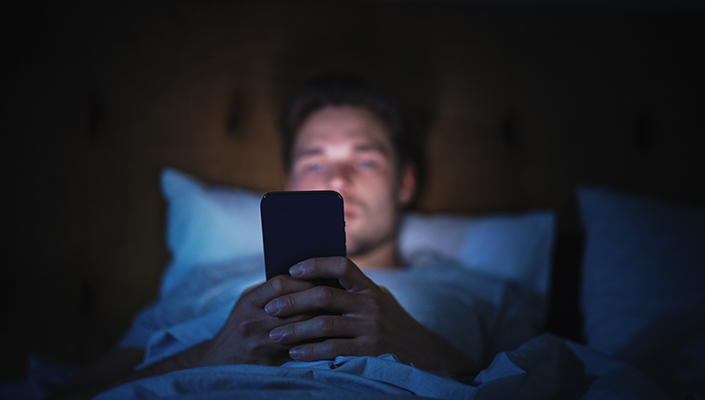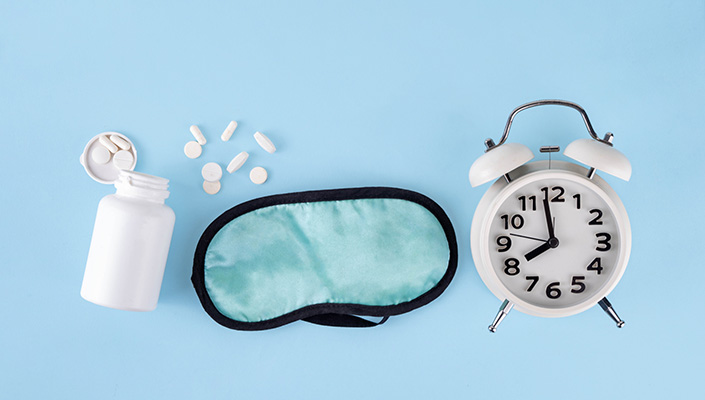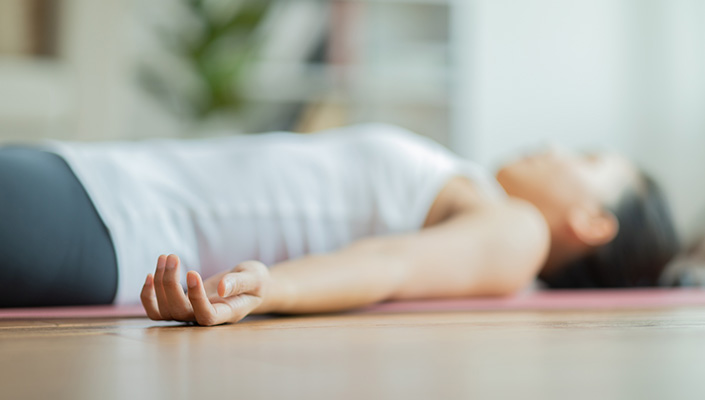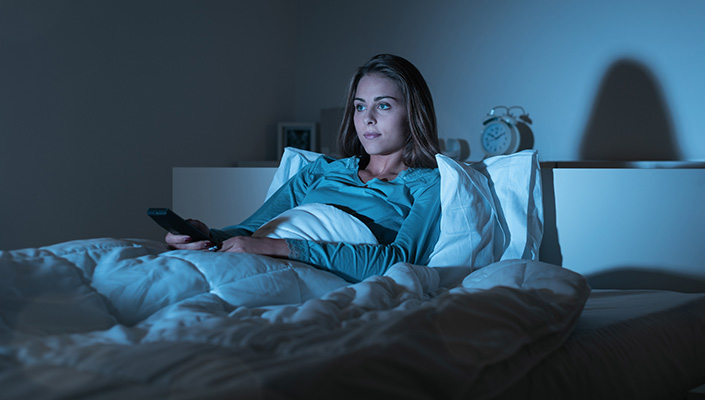Do TikTok’s Viral Life Hacks Actually Help Your Mental Health?
UC San Diego experts break down the science behind six of social media’s most popular coping strategies and self-care trends
Story by:
Published Date
Article Content
Social media is full of advice on how to feel calmer, happier and healthier: Just try a cortisol "cocktail," spend a day “rotting” in bed or manifest your dream life into reality. These viral trends claim to relieve stress, boost happiness and improve mental health—but do they actually?
In honor of Mental Health Awareness Month, we asked UC San Diego experts to weigh in on six popular coping strategies and wellness trends. Here’s what to know before you give them a try:

Brainrot: Is consuming mindless content a healthy way to escape?
Oxford’s 2024 word of the year wasn’t something lofty—it was “brainrot,” a nod to those endless hours spent watching irresistibly cute or mind-numbing content online. Think Moo Deng the baby hippo, soap-cutting videos or the oddly satisfying sight of perfectly restocked, color-coded fridges. But can zoning out with this kind of digital escapism actually harm our brains?
“Although the term ‘brainrot’ may sound like a joke, zoning out to short-form, stimulating content can alter how the brain develops and functions,” says Assistant Professor of Psychiatry Ekta Patel, M.D. “Over time, this can desensitize the brain’s natural reward pathway, making everyday activities such as work, school, reading or face-to-face conversations feel boring or mundane in comparison.”
Patel emphasizes that it’s not all bad. “Turning to light, feel-good content to unwind or disconnect is not inherently harmful; in fact, it can be a low-stakes way to regulate in small doses,” she says. But she cautions, “When this kind of content consumption becomes the primary way to manage distress, it can drift into what we call emotional avoidance or dissociation.”
The takeaway? Enjoy your Moo Deng fix, but don’t forget to unplug and reconnect with the real world, too.
“The key is intention. Are we using it to gently recharge, or to disconnect completely from our internal world? This question can help answer if it’s a coping tool or a barrier to healing,” Patel adds.
When this kind of content consumption becomes the primary way to manage distress, it can drift into what we call emotional avoidance or dissociation.

Cortisol ‘cocktails’: Can a trendy drink really lower stress?
A so-called cortisol “cocktail” is taking over our social media feeds, promising to lower stress hormones with a simple mix of orange juice, sea salt, coconut water and a magnesium supplement. Cortisol—the body’s primary stress hormone—is released by the adrenal glands and plays a key role in regulating blood pressure, metabolism, inflammation and the body’s response to stress. Can sipping this viral drink really calm your nervous system?
“While a ‘cortisol cocktail’ has been promoted as an easy solution to battle burnout, the scientific data to support such claims is not as conclusive,” says endocrinologist Jodi Nagelberg, M.D., M.H.A., an assistant clinical professor of medicine. “It may taste refreshing, but claiming such a cocktail is a ‘fix’ for the effects of chronic stress on one’s body is an exaggeration at best.”
Nagelberg explains that while some ingredients, like magnesium, have shown limited evidence of affecting cortisol metabolism, others haven’t been well studied or have effects too minor to make a real impact. “If one does feel improved after taking such an antidote, a placebo effect alone cannot be discounted,” she adds.
She also warns that obsessively trying to “fix” cortisol levels can backfire. “Typically, there is no need to ‘fix’ one’s cortisol levels, but rather target the underlying cause of chronic stress as a means of improving one’s overall health.”
“While many of these hacks may be safe yet ineffective, excessive intake of various vitamins or minerals can cause physical harm,” she says. And though the ingredients in the cortisol cocktail are generally safe, Nagelberg recommends consulting a health care provider before adopting any self-prescribed wellness routine.
It may taste refreshing, but claiming such a cocktail is a ‘fix’ for the effects of chronic stress on one’s body is an exaggeration at best.

Sleepmaxxing: Is chasing perfect sleep making you sleepless?
From piling on weighted blankets to taping your mouth shut at night to encourage nasal breathing or eating kiwis—which are naturally rich in serotonin—before bed, social media is full of advice on how to “sleepmaxx.” The practice involves stacking multiple sleep strategies in search of perfect rest, but it turns out it may do more harm than good.
“Experts agree optimal sleep duration is seven to nine hours a night. Getting insufficient sleep is linked with poor health, but going beyond nine hours is also associated with bad outcomes, including earlier mortality,” says Professor of Psychiatry Michael McCarthy, M.D., Ph.D., who has studied the intersection of circadian rhythms and mental health. He cautions that some popular remedies may alter sleep cycles, like reducing rapid eye movement [REM] sleep, which is vital for emotional and cognitive health. “Moreover, most home remedies stop working after a few nights as people become tolerant to them.”
McCarthy says some strategies have merit—keeping the room dark and cool, managing stress and using white noise if ambient sounds are an issue. But other hacks, like mouth taping and certain supplements “have not been well-studied for sleep and may come with unanticipated and unwanted effects on health.”
Ironically, he says, the quest for perfect sleep can make things worse. “Anxiety of any kind, including obsessive worrying about sleep, can cause sleep problems,” McCarthy explains. Over time, this worry can turn into catastrophic thinking: ‘If I don’t get a full eight hours, my day tomorrow will be a disaster,’ which only deepens sleep difficulties and can lead to chronic insomnia.
His advice? Keep it simple. “Keeping a consistent sleep-wake schedule is helpful and trains the body to know when sleep should come. Spending time outdoors, especially in the early morning, is key to maintaining healthy circadian rhythms,” McCarthy says.
Anxiety of any kind, including obsessive worrying about sleep, can cause sleep problems.

Manifesting: Can positive thinking change your life?
Manifesting—thinking your dream life into existence—is having a major moment online. From TikTok tutorials on scripting your future romance to Instagram reels promising career success through vision boards, the idea is simple: focus hard enough on what you want, and it will come true. Is it really that easy?
“Where your mind goes, your energy flows,” says E. Nathaniel Chapman, Psy.D., assistant teaching professor of psychology in the School of Social Sciences. He explains that while positive thinking can set a powerful foundation, it’s just the first step. “Optimism provides the groundwork, but behavioral follow-through is required for lasting success,” he says.
Think of manifesting like planning a trip, Chapman explains. You can plot the destination, but you’ll still have to navigate rough waters and detours to get there. The danger comes when people believe thinking alone is enough. “Entitlement—expecting something for nothing—can be detrimental,” he cautions, leading to frustration and even mental health struggles when reality doesn’t match expectations.
Positive thinking can fuel motivation and resilience, but it’s action that drives results. As Chapman puts it, “If you have a clear goal and stay focused, your brain will start creating plans—but you have to act on them. That’s when the rough waters come. Not every plan will work, but if you keep adjusting and trying again, you’ll eventually get to where you’re going."
Not every plan will work, but if you keep adjusting and trying again, you’ll eventually get to where you’re going.

Floor time: Can lying on the floor really help you relax?
Lying flat on the floor might not look like self-care, but according to clinical professor Pollyanna Casmar, Ph.D., in the Department of Psychiatry, this viral “floor time” trend may actually have serious mental health benefits. Popularized on TikTok, the practice has people stretching out on carpets, hardwood floors and even grass as a simple way to unwind, reduce stress and escape the constant buzz of daily life. It’s also a familiar practice in yoga, where the final resting pose, known as shavasana, is used to promote relaxation and mindful awareness.
“When you lie down, you connect with your body rather than your mind—that’s the first thing that happens,” says Casmar. This simple act grounds you, helping quiet mental noise and bringing awareness to physical sensations. “We’re so caught in our heads all the time that we lose touch with what’s happening in our bodies,” she explains.
Casmar notes that lying on a firm surface encourages natural relaxation and smoother breathing, which in turn helps activate the parasympathetic nervous system—the body’s built-in calm mode. Over time, this kind of practice helps regulate stress and restore balance.
And for those moments when you can’t stretch out on the floor? She suggests focusing on points of physical contact—your feet on the ground or your back against a chair—and practicing “vagus breathing,” a simple technique that calms the nervous system with slow, intentional breaths. You can activate your vagus nerve by breathing in and sighing out slowly and longer than your “in breath,” with an open mouth. Mentally scan your body without attempting to change anything while continuing this breath to complete a meditative body scan, Casmar says.
This simple practice of lying down and focusing on the breath offers a powerful reminder: you don’t have to do anything special to find calm—just pause, breathe and reconnect with your body.
We’re so caught in our heads all the time that we lose touch with what’s happening in our bodies.

Bed rotting: When does rest turn into avoidance?
“Bed rotting” is the latest viral self-care trend convincing people to spend entire days tucked under the covers—not sleeping, but scrolling, streaming and opting out of life’s demands. While it can feel like a soothing escape from burnout, too much time disconnected from physical movement and real-world interaction can start to take a toll on mental health.
“Sometimes your body really does need a day of rest, and you shouldn’t shame yourself for that,” says mindfulness expert and Professor of Psychology Karen Dobkins, Ph.D. “But there are also days your body needs to move. I don’t have a prescription except to say: pay attention. The key is learning to listen.”
Dobkins explains that prolonged inactivity can weaken your connection to both body and mind, making it harder to notice what you really need—a concept known as interoception, or sensing the internal state of your body. “If you don’t use your body, then you’re not building a relationship with it,” she says. “Bodies have important signals for us all day long—not just hunger, but stress, discomfort and more.”
To foster a more balanced, whole-person approach to mental health, Dobkins suggests exploring UC San Diego’s Learning Sustainable Well-Being program, a series of life-skills courses she founded to help students develop practical tools for emotional resilience and self-compassion. “Everyone understands that if you want to take care of your body, you have to make it a regular practice,” she says. “It’s the same with your heart and emotional well-being—what practices do you have in place? Real care requires a commitment to lifestyle."
Sometimes your body really does need a day of rest, and you shouldn’t shame yourself for that.
You May Also Like
Stay in the Know
Keep up with all the latest from UC San Diego. Subscribe to the newsletter today.



